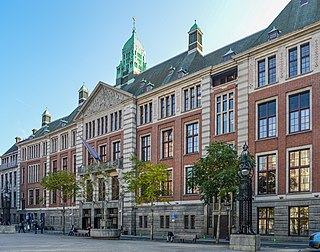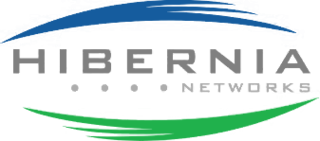Related Research Articles
Latency, from a general point of view, is a time delay between the cause and the effect of some physical change in the system being observed. Lag, as it is known in gaming circles, refers to the latency between the input to a simulation and the visual or auditory response, often occurring because of network delay in online games.

The New York Stock Exchange is an American stock exchange in the Financial District of Lower Manhattan in New York City. It is the largest stock exchange in the world by market capitalization.
A transatlantic telecommunications cable is a submarine communications cable connecting one side of the Atlantic Ocean to the other. In the 19th and early 20th centuries, each cable was a single wire. After mid-century, coaxial cable came into use, with amplifiers. Late in the 20th century, all cables installed use optical fiber as well as optical amplifiers, because distances range thousands of kilometers.

Euronext N.V. is a pan-European bourse that provides trading and post-trade services for a range of financial instruments.

Hibernia Networks, alternately known as Hibernia Atlantic, was a privately held, US-owned provider of telecommunication services. It operated global network routes on self-healing rings in North America, Europe and Asia including submarine communications cable systems in the North Atlantic Ocean which connected Canada, the United States, the Republic of Ireland, the United Kingdom and mainland Europe. Hibernia managed cable landing stations in Dublin, Republic of Ireland; Coleraine, Northern Ireland; Southport, England; Halifax, Canada; Lynn, Massachusetts, United States.

AboveNet was a provider of high bandwidth telecommunication circuits primarily for large corporate enterprises and communications carriers in 17 markets in the United States and 4 markets in Europe. Its private optical network delivered key network and IP services and was used in financial and legal services, media, health care, retail, and government.
Numericable was a major French cable operator and telecommunications services company. Numericable was originally created in 2007 from the merger between former competitors Noos and NC Numericable networks. Numericable Group SA was founded in August 2013 to act as the parent company of Numericable group companies and to offer its shares on the stock exchange. The company provides cable broadband services in France, Luxembourg and Portugal, offering digital and analog television, Internet, and phone services to homes. From 2008, Numericable also offered mobile telephone services to its customers.

Fiber-optic communication is a method of transmitting information from one place to another by sending pulses of infrared or visible light through an optical fiber. The light is a form of carrier wave that is modulated to carry information. Fiber is preferred over electrical cabling when high bandwidth, long distance, or immunity to electromagnetic interference is required. This type of communication can transmit voice, video, and telemetry through local area networks or across long distances.

A fiber-optic cable, also known as an optical-fiber cable, is an assembly similar to an electrical cable but containing one or more optical fibers that are used to carry light. The optical fiber elements are typically individually coated with plastic layers and contained in a protective tube suitable for the environment where the cable is used. Different types of cable are used for fiber-optic communication in different applications, for example long-distance telecommunication or providing a high-speed data connection between different parts of a building.
In capital markets, low latency is the use of algorithmic trading to react to market events faster than the competition to increase profitability of trades. For example, when executing arbitrage strategies the opportunity to "arb" the market may only present itself for a few milliseconds before parity is achieved. To demonstrate the value that clients put on latency, in 2007 a large global investment bank has stated that every millisecond lost results in $100m per annum in lost opportunity.
Lexent Metro Connect was a New York City based neutral telecommunications provider that owned, operated, built and maintained its own dark fiber network in New York, Northern New Jersey, and surrounding areas. Based in New York City, Lexent provided services in the boroughs of Manhattan, the Bronx, Queens, and Brooklyn, as well as in Northern New Jersey. It had 150 fiber route miles and served over 200 commercial buildings.

Verizon Fios is a bundled Internet access, telephone, and television service provided by Verizon Communications that operates over a fiber optical network within the United States.
360networks, Inc. was a Canadian-based wholesale telecommunications carrier. The company developed many long-haul fiber optic communications network routes throughout North America, many along railroad rights of way, consisting of both dark fiber and lit fiber. These long-haul routes included Chicago to New Orleans, Chicago to Denver, Chicago to Detroit, Chicago to New York, Seattle to Los Angeles, and Denver to San Francisco. In 2011, the company was acquired by Zayo Group.
Lightower Fiber Networks, founded in 2006, was a provider of telecommunications and IT services. It offered cloud computing, colocation hosting, and connectivity.
A fiber-optic patch cord is a fiber-optic cable capped at each end with connectors that allow it to be rapidly and conveniently connected to telecommunication equipment. This is known as interconnect-style cabling.

Zayo Group Holdings, Inc., or Zayo Group, is a privately held company headquartered in Boulder, Colorado, U.S. with European headquarters in London, England. The company provides communications infrastructure services, including fiber and bandwidth connectivity, colocation and cloud infrastructure. Zayo's primary customer segments include wireless carriers, national carriers, ISPs, enterprises and government agencies. Zayo Group was built largely through acquisitions; it took over thirty companies from 2007 to 2014, including AboveNet and 360networks. The company completed an initial public offering of stock raising $600 million in 2014. In 2020, Zayo Group was taken private by global investment firms EQT AB and Digital Colony Partners in a deal valued at $14.3 billion.

Flash Boys: A Wall Street Revolt is a book by the American writer Michael Lewis, published by W. W. Norton & Company on March 31, 2014. The book is a non-fiction investigation into the phenomenon of high-frequency trading (HFT) in the US financial market, with the author interviewing and collecting the experiences of several individuals working on Wall Street. Lewis concludes that HFT is used as a method to front run orders placed by investors. He goes further to suggest that broad technological changes and unethical trading practices have transformed the U.S. stock market from "the world's most public, most democratic, financial market" into a "rigged" market.

Investors Exchange (IEX) is a stock exchange in the United States. It was founded in 2012 in order to mitigate the effects of high-frequency trading. IEX was launched as a national securities exchange in September 2016. On October 24, 2017, it received regulatory approval from the U.S. Securities and Exchange Commission (SEC) to list companies. IEX listed its first public company, Interactive Brokers, on October 5, 2018. The exchange said that companies would be able to list for free for the first five years, before a flat annual rate of $50,000. On September 23, 2019, it announced it was leaving its listing business.
Hibernia Express is a submarine communications cable system which was privately owned by Hibernia Networks linking Canada, Ireland, and the UK. Hibernia Express is now owned by telecommunications provider GTT Communications, Inc. after their acquisition of Hibernia Networks. At 58.95ms of latency, the cable is currently the lowest latency fiber optic route between the NY4 data center in Secaucus, New Jersey and London.

165 Halsey Street, formerly known as the Bamberger Building, is a 14-story, office tower in Downtown Newark, New Jersey. Built in 1912–1929, it was designed by Jarvis Hunt. The building spans the entire block between Halsey Street, Market Street, Washington Street, and Bank Street. 165 Halsey Street is a major colocation center in New York metropolitan area; according to Center for Land Use Interpretation, it is among the world's largest carrier hotels. It is a contributing property to the Four Corners Historic District.
References
- ↑ "Spread Networks". Spread Networks. Retrieved January 26, 2014.
- 1 2 "Network Map: The Shortest and Straightest Routes Available". Spread Networks. Retrieved January 26, 2014.
- 1 2 3 Troianovski, Anton (April 3, 2012). "Optical Delusion? Fiber Booms Again, Despite Bust" . The Wall Street Journal . Excelsior Springs. Retrieved January 26, 2014.
- 1 2 3 4 Adler, Jerry (August 3, 2012). "Raging Bulls: How Wall Street Got Addicted to Light-Speed Trading". Wired Magazine . Retrieved January 26, 2014.
- 1 2 3 4 5 6 7 Steiner, Christopher (September 9, 2010). "Wall Street's Speed War". Forbes . Retrieved January 26, 2014.
- ↑ Buckley, Sean (June 23, 2010). "Spread Networks tightens up latency along Chicago to New York route". Fierce Telecom. Retrieved January 26, 2014.
- ↑ "Spread Networks Announces Expansion of Low Latency Wave Service to Secaucus" (Press release). Spread Networks. 2011-02-07. Retrieved 2021-10-21.
- ↑ "Spread Networks Announces Expansion of Low Latency Wave Service to Weehawken" (Press release). Spread Networks. 2011-02-28. Retrieved 2021-10-21.
- ↑ "Spread Networks Announces Expansion of Low Latency Wave Service to Newark" (Press release). Spread Networks. 2011-03-14. Retrieved 2021-10-21.
- 1 2 "Spread Networks improves latency on Chicago-New York route". LIGHTWAVE. October 8, 2012. Retrieved January 26, 2014.
- ↑ "Spread Networks Opens Point of Presence at NYSE Euronext Mahwah: Fastest fiber optic network connection between New Jersey and Chicago now available at Mahwah". PRNewsWire. January 10, 2014. Retrieved January 26, 2014.
- ↑ "ZAYO TO ACQUIRE SPREAD NETWORKS". Zayo. November 27, 2017. Retrieved August 29, 2019.
- ↑ "Zayo to buy Spread Networks for $127 million in cas". Lightwave / Endeavor Business Media, LLC. November 27, 2017. Retrieved August 29, 2019.
- ↑ "Carteret to Chicago Dark Fiber – 13.00 milliseconds roundtrip". Spread Networks. Retrieved January 26, 2014.
- ↑ "Spread Networks Latencies for Ultra Low Latency Services" (PDF). Spread Networks. Retrieved January 26, 2014.
- ↑ Schmercken, Ivy (March 28, 2011). "Spread Networks Clocks Latency Under 14.75 Milliseconds". Wall Street and Tech. Retrieved January 26, 2014.